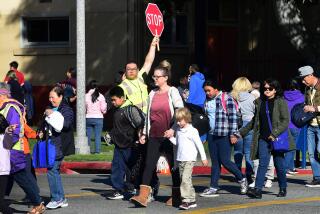Taking the Safe Way to School and Back
- Share via
By now, parents have purchased the new lunch boxes and pencil cases. The school clothes have been ironed and battles have been waged to push bedtime up to 8 p.m.
But, have you done the most important task in preparation for back to school? Have you and your children worked out a plan for safe transport to and from school?
This is a chore that too many families overlook, says Pat Hines, founder of the acclaimed child transportation safety program Safe Moves. The Los Angeles-based, nonprofit program has been advising consumers on traffic safety since 1984.
“Traffic accidents are the leading cause of death among children,” Hines says. “But we, as a population, have accepted children being killed by traffic as an everyday occurrence. Yes, it’s tragic, but it’s an accident. Parents need to be outraged and demand a stop to their children being at risk.”
Hines has studied how children move to and from school and has nightmares about what she has seen.
“We call the pickup and drop-off zones in front of schools the danger zones,” she says. “You see the worst traffic behavior of parents during those times. Parents double-park. They tell their kids to dart through traffic. We see parents who barely slow down to drop their kids off.”
So deadly are the packed parking lots and busy streets immediately in front of school doors that Hines urges families to find drop-off points a block, or even two blocks, away from school.
“Walking one or two blocks and crossing at the crosswalks is often safer than being dropped off close to the school doors,” she says.
The good advice dispensed by Safe Moves recently caught the attention of top government officials, and the organization received the 1996 U.S. Child Transportation Safety Program of the Year award.
It’s all a labor of love for Hines, who gives free demonstrations on safety to school and community groups. Here are more of her safety tips:
* Children should not be allowed to play at or around a bus stop.
* Children should be told to follow the bus driver’s instructions when crossing the street.
* Children dropped off from the school bus should await their parents on the same side of the street.
* On the bus, children should hold on to the seat in front of them.
* Children should keep their heads, hands and arms inside the bus.
* Children should carry backpacks small enough to place under the seats; big packs push children forward so they can’t sit securely in their seats.
* When dropping off children from a car, make sure they enter and exit on the passenger side, nearest the sidewalk.
* Children should have their lunches, jackets, backpacks, homework, books or lunch money accounted for and in hand before opening the car door at the drop-off point. This will eliminate dangerous, impulsive dashes back to the car for forgotten items.
* Parents need to plan the child’s walking or biking route to school and practice it before opening day.
“No matter what grade they are in, you need to practice walking it during the morning and afternoon at the time they will actually be there. Get to know the route. How long does it take? Are there safe houses along the route [where a child could seek help or refuge if problems arise]? We tell parents, ‘Look at what your child is facing,’ ” Hines says.
* Choose the safest route to walk or bike to school, even if it’s not the shortest.
* Children who walk to school without an adult should be old enough to cross streets safely, which usually isn’t achieved until about age 10.
* Teach children to obey all traffic signs, signals and street markings.
* Never cross the street mid-block. Use crosswalks.
* When crossing the street, look in all directions, including forward and behind you.
* Follow your school’s traffic-management plan to the letter.
*
More back-to-school coverage Thursday: Dark denim crosses clique lines on campus.
More to Read
Sign up for Essential California
The most important California stories and recommendations in your inbox every morning.
You may occasionally receive promotional content from the Los Angeles Times.









